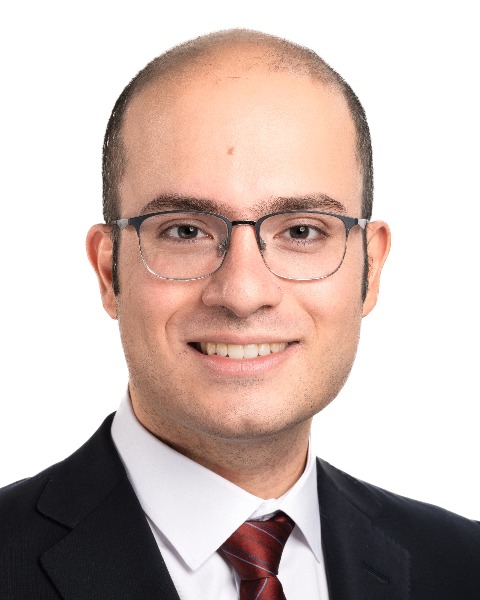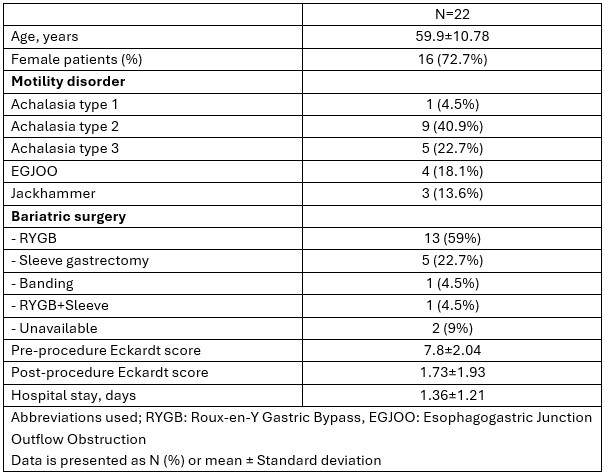Sunday Poster Session
Category: Interventional Endoscopy
P1394 - Efficacy and Safety of Esophageal Peroral Endoscopic Myotomy (E-POEM) in Patients With History of Bariatric Surgery: A Multicenter Retrospective Study
Sunday, October 26, 2025
3:30 PM - 7:00 PM PDT
Location: Exhibit Hall

Babak Mirminachi, MD (he/him/his)
University of Pittsburgh Medical Center
Harrisburg, PA
Presenting Author(s)
Babak Mirminachi, MD1, Lizeth Cifuentes, MD2, Muhammad Ali Butt, MD3, Thomas Gonzales, MD2, Joo Ha. Hwang, MD4, Andrew Li, MD4, Alexander Schlachterman, MD5, Sunil Amin, MD, MPH6, Shyam Thakkar, MD7, Pritesh Mutha, MD8, Abel Joseph, MD9, Walli Ansari, 10, George Obeng, MD7, Yeshaswini Reddy, MD11, Mohammad Al-Haddad, MD12, Sultan Mahmood, MD2
1University of Pittsburgh Medical Center, Harrisburg, PA; 2University of Pittsburgh Medical Center, Pittsburgh, PA; 3Beth Israel Lahey Hospital and Medical Center, Burlington, MA; 4Stanford University, Stanford, CA; 5Sidney Kimmel Medical College at Thomas Jefferson University, Philadelphia, PA; 6University of Miami Health System, Miami, FL; 7West Virginia University, Morgantown, WV; 8University of Texas at Houston, Houston, TX; 9Stanford University, Redwood City, CA; 10Thomas Jefferson University Hospital, Philadelphia, PA; 11McGovern Medical School at UTHealth, Houston, TX; 12Indiana University School of Medicine, Indianapolis, IN
Introduction: Achalasia affects up to 7.2% of post Roux-en-Y gastric bypass (RYGB) or sleeve gastrectomy (SG) patients, often years later and confirmed by manometry. Altered anatomy creates distinct esophageal peroral endoscopic myotomy (E-POEM) challenges: RYGB distorts the gastroesophageal junction (GEJ), requiring tunnel extension into the pouch or Roux limb, while SG yields a narrow, scarred sleeve that can limit distal myotomy. Small series report technical success of 97.5–100% and clinical relief of 67–100% with tailored modifications, myotomy orientation, careful tunneling, and adjusted lengths. However, limited cohorts, follow-up, and inconsistent outcome definitions necessitate larger multicenter studies.
Methods: Between 2020 and 2024, we retrospectively reviewed adult achalasia patients with prior RYGB or SG who underwent E-POEM at six tertiary U.S. centers. Patient demographics, procedural details, and follow-up outcomes were collected. The primary endpoint was clinical success defined as Eckardt score ≤3 at 6 months. Secondary endpoints included technical success (completion of planned myotomy) and adverse events.
Results: A total of 22 patients (mean age: 59.9 ± 10.7 years; 16 female) with achalasia and a history of bariatric surgery underwent E-POEM with median follow up of 12 months. Thirteen patients (59%) had undergone RYGB, five (22.7%) sleeve gastrectomy and one gastric banding. All procedures were technically successful , with posterior myotomy performed in 18 patients. The mean±SD myotomy length was 10.81±5.91 cm , extending an average of 2.5 cm beyond the GEJ. The mean procedure duration was 50.5 minutes, and the average hospital stay was 1.36 days. Post-procedure complications included chest pain in two patients and regurgitation in two patients. The post-procedure Eckardt score was available for 19 patients, with clinical success achieved in 17 (89.4%).
Discussion: E-POEM is both feasible and effective in achalasia patients with prior bariatric surgery, supporting its use as first-line therapy in this group. Limitations include retrospective design, small cohorts, and inconsistent outcome measures. Prospective multicenter trials with standardized endpoints are needed.

Figure: Table 1. Clinical Characteristics of Patients with Prior Bariatric Surgery Undergoing Esophageal Peroral Endoscopic Myotomy (E-POEM) for Refractory Gastroparesis

Figure: Table 2- Participating Institutions and Number of Patients at Each Center
Disclosures:
Babak Mirminachi indicated no relevant financial relationships.
Lizeth Cifuentes indicated no relevant financial relationships.
Muhammad Ali Butt indicated no relevant financial relationships.
Thomas Gonzales indicated no relevant financial relationships.
Joo Hwang indicated no relevant financial relationships.
Andrew Li indicated no relevant financial relationships.
Alexander Schlachterman: Boston Scientific – Consultant. FujiFilm – Consultant. Laborie – Consultant. Lumendi – Consultant. Microtech – Consultant. Olympus – Consultant.
Sunil Amin: 3D Matrix – Consultant. Boston Scientific – Consultant. Medtronic – Consultant.
Shyam Thakkar indicated no relevant financial relationships.
Pritesh Mutha indicated no relevant financial relationships.
Abel Joseph indicated no relevant financial relationships.
Walli Ansari indicated no relevant financial relationships.
George Obeng indicated no relevant financial relationships.
Yeshaswini Reddy indicated no relevant financial relationships.
Mohammad Al-Haddad: Amplified Sciences – Grant/Research Support. Boston Scientific – Consultant. Interpace diagnostics – Consultant.
Sultan Mahmood indicated no relevant financial relationships.
Babak Mirminachi, MD1, Lizeth Cifuentes, MD2, Muhammad Ali Butt, MD3, Thomas Gonzales, MD2, Joo Ha. Hwang, MD4, Andrew Li, MD4, Alexander Schlachterman, MD5, Sunil Amin, MD, MPH6, Shyam Thakkar, MD7, Pritesh Mutha, MD8, Abel Joseph, MD9, Walli Ansari, 10, George Obeng, MD7, Yeshaswini Reddy, MD11, Mohammad Al-Haddad, MD12, Sultan Mahmood, MD2. P1394 - Efficacy and Safety of Esophageal Peroral Endoscopic Myotomy (E-POEM) in Patients With History of Bariatric Surgery: A Multicenter Retrospective Study, ACG 2025 Annual Scientific Meeting Abstracts. Phoenix, AZ: American College of Gastroenterology.
1University of Pittsburgh Medical Center, Harrisburg, PA; 2University of Pittsburgh Medical Center, Pittsburgh, PA; 3Beth Israel Lahey Hospital and Medical Center, Burlington, MA; 4Stanford University, Stanford, CA; 5Sidney Kimmel Medical College at Thomas Jefferson University, Philadelphia, PA; 6University of Miami Health System, Miami, FL; 7West Virginia University, Morgantown, WV; 8University of Texas at Houston, Houston, TX; 9Stanford University, Redwood City, CA; 10Thomas Jefferson University Hospital, Philadelphia, PA; 11McGovern Medical School at UTHealth, Houston, TX; 12Indiana University School of Medicine, Indianapolis, IN
Introduction: Achalasia affects up to 7.2% of post Roux-en-Y gastric bypass (RYGB) or sleeve gastrectomy (SG) patients, often years later and confirmed by manometry. Altered anatomy creates distinct esophageal peroral endoscopic myotomy (E-POEM) challenges: RYGB distorts the gastroesophageal junction (GEJ), requiring tunnel extension into the pouch or Roux limb, while SG yields a narrow, scarred sleeve that can limit distal myotomy. Small series report technical success of 97.5–100% and clinical relief of 67–100% with tailored modifications, myotomy orientation, careful tunneling, and adjusted lengths. However, limited cohorts, follow-up, and inconsistent outcome definitions necessitate larger multicenter studies.
Methods: Between 2020 and 2024, we retrospectively reviewed adult achalasia patients with prior RYGB or SG who underwent E-POEM at six tertiary U.S. centers. Patient demographics, procedural details, and follow-up outcomes were collected. The primary endpoint was clinical success defined as Eckardt score ≤3 at 6 months. Secondary endpoints included technical success (completion of planned myotomy) and adverse events.
Results: A total of 22 patients (mean age: 59.9 ± 10.7 years; 16 female) with achalasia and a history of bariatric surgery underwent E-POEM with median follow up of 12 months. Thirteen patients (59%) had undergone RYGB, five (22.7%) sleeve gastrectomy and one gastric banding. All procedures were technically successful , with posterior myotomy performed in 18 patients. The mean±SD myotomy length was 10.81±5.91 cm , extending an average of 2.5 cm beyond the GEJ. The mean procedure duration was 50.5 minutes, and the average hospital stay was 1.36 days. Post-procedure complications included chest pain in two patients and regurgitation in two patients. The post-procedure Eckardt score was available for 19 patients, with clinical success achieved in 17 (89.4%).
Discussion: E-POEM is both feasible and effective in achalasia patients with prior bariatric surgery, supporting its use as first-line therapy in this group. Limitations include retrospective design, small cohorts, and inconsistent outcome measures. Prospective multicenter trials with standardized endpoints are needed.

Figure: Table 1. Clinical Characteristics of Patients with Prior Bariatric Surgery Undergoing Esophageal Peroral Endoscopic Myotomy (E-POEM) for Refractory Gastroparesis

Figure: Table 2- Participating Institutions and Number of Patients at Each Center
Disclosures:
Babak Mirminachi indicated no relevant financial relationships.
Lizeth Cifuentes indicated no relevant financial relationships.
Muhammad Ali Butt indicated no relevant financial relationships.
Thomas Gonzales indicated no relevant financial relationships.
Joo Hwang indicated no relevant financial relationships.
Andrew Li indicated no relevant financial relationships.
Alexander Schlachterman: Boston Scientific – Consultant. FujiFilm – Consultant. Laborie – Consultant. Lumendi – Consultant. Microtech – Consultant. Olympus – Consultant.
Sunil Amin: 3D Matrix – Consultant. Boston Scientific – Consultant. Medtronic – Consultant.
Shyam Thakkar indicated no relevant financial relationships.
Pritesh Mutha indicated no relevant financial relationships.
Abel Joseph indicated no relevant financial relationships.
Walli Ansari indicated no relevant financial relationships.
George Obeng indicated no relevant financial relationships.
Yeshaswini Reddy indicated no relevant financial relationships.
Mohammad Al-Haddad: Amplified Sciences – Grant/Research Support. Boston Scientific – Consultant. Interpace diagnostics – Consultant.
Sultan Mahmood indicated no relevant financial relationships.
Babak Mirminachi, MD1, Lizeth Cifuentes, MD2, Muhammad Ali Butt, MD3, Thomas Gonzales, MD2, Joo Ha. Hwang, MD4, Andrew Li, MD4, Alexander Schlachterman, MD5, Sunil Amin, MD, MPH6, Shyam Thakkar, MD7, Pritesh Mutha, MD8, Abel Joseph, MD9, Walli Ansari, 10, George Obeng, MD7, Yeshaswini Reddy, MD11, Mohammad Al-Haddad, MD12, Sultan Mahmood, MD2. P1394 - Efficacy and Safety of Esophageal Peroral Endoscopic Myotomy (E-POEM) in Patients With History of Bariatric Surgery: A Multicenter Retrospective Study, ACG 2025 Annual Scientific Meeting Abstracts. Phoenix, AZ: American College of Gastroenterology.
